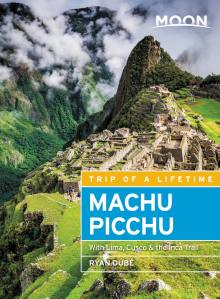Transportation In and Around Machu Picchu
There are various ways to reach Aguas Calientes, the town at the base of Machu Picchu. You can take the Inca Trail or the Salcantay route, ride the train from Ollantaytambo (90 minutes) or from near Cusco (2.5 hours), take the Inca Jungle Trail, or take the bus through Santa Teresa. In Aguas Calientes, there are frequent bus shuttles to Machu Picchu, though some choose the two-hour forest hike that cuts across the road’s switchbacks. Once inside Machu Picchu, the only way to get around is by foot.

Taking the Train to Aguas Calientes
The breakup of the longtime PeruRail monopoly has so far failed to bring down prices, and there is no escaping that the train is expensive by backpacker standards. Expect to pay US$75 one-way (US$120 round-trip). Before booking train service to Machu Picchu or asking your hotel to book trains for you, check the websites of the companies.
Inca Rail (Portal de Panes St. 105, Plaza de Armas, Cusco, tel. 084/58-1860) has two trains that offer a number of daily departures from Ollantaytambo to Machu Picchu. The Machu Picchu Train leaves Ollantaytambo daily at 7:20am, arriving in Aguas Calientes 90 minutes later. It leaves for Ollantaytambo on the return trip at 4:12pm. Prices vary according to time but are approximately US$75 one-way.
The second train, Inca Train, offers three daily departures from Ollantaytambo at 6:40am, 11:15am, and 4:36pm, as well as three daily departures from Aguas Calientes at 8:30am, 2:30pm, and 7pm. The trains have an executive class (US$50 one-way) and a first class (US$75 one-way).
The traditional option is PeruRail (Av. Pachacútec, Cusco, tel. 084/58-1414), which offers train service from Ollantaytambo, Pachar (about an hour and a half from Cusco), and Poroy (near Cusco) to Aguas Calientes. The price varies depending on the station and train; the company offers the Expedition (US$140-240 round-trip, US$70 one-way), the Vistadome (US$160-260 round-trip, US$90 one-way), and the luxury Hiram Bingham service (US$588 round-trip, US$334 one-way). The Expedition train is nearly as comfortable as the Vistadome, with large, soft seats and plenty of legroom. Food for sale includes sandwiches (US$4) and candy bars (US$2). The perks of the Vistadome include large viewing windows in the ceilings, shows put on by train attendants (including fashion walks to promote alpaca clothing), luxurious seats, lights snacks and beverages, and live Andean music.
The Hiram Bingham service is in a whole different league. A full brunch is served on the ride from Poroy (15 minutes outside Cusco) to Machu Picchu, where guests are treated to a deluxe ruins tour and a full tea at the Sanctuary Lodge. On the ride home, predinner pisco sours are served in the elegant dark-wood bar, accompanied by a live band and dancing. A gourmet four-course dinner follows at your private table, accompanied by a selection of wines. Afterwards, there is live music and dancing for those with energy. Hands down, this is the most luxurious train service in Latin America. If it feels like the Orient Express, that’s because it is—PeruRail has been operated by Orient-Express Ltd. since the late 1990s.
All trains depart from Ollantaytambo or Pachar except the Hiram Bingham service. The Hiram Bingham luxury train avoids the famous (or infamous) switchbacks out of Cusco by leaving from the Poroy station, which is a 15-minute drive from Cusco. Its bus departs Cusco at 8:10am. The train leaves Poroy at 9:40am and arrives in Aguas Calientes at 12:30pm. On the return, the train departs Aguas Calientes at 5:50pm and gets to Poroy at 8:50pm. The bus returns to Cusco at 10pm.
The Cusco-Machu Picchu train crosses high, desolate plains before descending to meet the Urubamba Valley. Once past Ollantaytambo, the rail enters a gorge that grows narrower and deeper as it continues its descent. Look for occasional glimpses of snow-covered Verónica (5,750 meters) to the right. At kilometer 88 there is a modern bridge built on Inca foundations. As the vegetation and the air grow thicker, the train descends into what the Peruvians call the ceja de selva (eyebrow of the jungle), and the Río Urubamba starts crashing over house-sized boulders. The train continues until reaching Aguas Calientes.

Bus Journey from Santa Teresa
The elaborate bus ride to Machu Picchu via Santa Teresa is hardly worth it unless you are really counting your pennies. From the Terminal de Santiago in Cusco, take a bus to Santa María (six hours, US$3). From Santa María, it is a two-hour bus ride to Santa Teresa. From there, shared taxis called colectivos will take you across the river to Oroya, where you can take a 5:30pm train to Aguas Calientes (US$8), or where you can walk three hours to the town. No matter what, if you choose this route, you will need to spend the night in Aguas Calientes, which may put another dent in your pocket.

